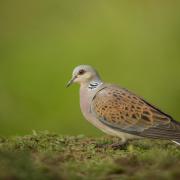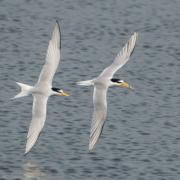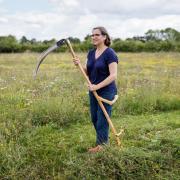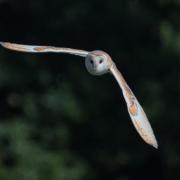Four hundred years ago, majestic, soaring cranes roamed Suffolk. Then hunting and habitat loss drove them away. Now a small colony of these precious birds has returned to our fenland
It was the day after Storm Eunice had blown through Suffolk, leaving felled branches and wood debris in its wake. The wind still had some force to it and there was an other worldliness to this damp, cold morning. It seemed to me, this was just the weather for going in search of giants.
I’d journeyed to the RSPB Lakenheath Fen reserve, just west of Thetford Forest, in the hope of catching a sight of Suffolk’s only colony of common cranes. At 4ft in height, the common crane is the UK’s tallest bird and is making a comeback on these shores after becoming extinct around 400 years ago.
Wild cranes were once widespread in these parts, to the point that place names mark their presence from yesteryear. On the map I noticed nearby named Cranwick Heath, so called because large numbers of this majestic bird no doubt once congregated here. Medieval texts tell of the crane being hunted for sport and feasts. This practice, coupled with the wholesale draining of its favoured wetland habitat to create prime farming land, led to the crane’s disappearance from Britain in the 17th century.

But recently things have been looking up for Grus grus, as the common crane is known scientifically, and East Anglia is at the centre of this uplifting revival story. In 1979, a small number of wild cranes turned up in the UK, most likely European birds blown off course. They colonised a small area of the Broads in Norfolk before spreading to other parts of eastern England and elsewhere in the UK. Today, it's estimated there are about 200 cranes mainly in the Fens, the Broads and the marshland of southwest England in Somerset where a small reintroduction programme as part of the Great Crane Project took place from 2010-2014.

Crucial to the cranes’ success have been efforts to restore reedbeds and other wetland habitats, which provide a place for it and other species to feed and nest. Incredibly, only 2 per cent of the Fens remain today, but latterly there has been a growing realisation of the importance of this wonderful landscape, both as a home for wildlife and as a store for carbon in its peat soil.
Carrots to cranes
The creation and improvement of wetland habitats such as at RSPB Lakenheath Fen in Suffolk and RSPB Nene Washes in Cambridgeshire has significantly aided the recent success of the crane in the east. Lakenheath Fen site manager David Rogers tells me that when the RSPB bought the site in 1995 it was a carrot field, but its location next to the Little Ouse River led conservationists to believe they could partially flood the site and create a wetland teeming with wildlife.
And what a transformation. There are now nearly 400 hectares of species rich habitat on the reserve including wet reedbed, ungrazed fen and wet grassland. A startling indication of the RSPB's success here can be gleaned by comparing two surveys. One is from the first year of the reserve’s life, when just 24 reed and sedge warblers, and reed buntings were recorded. The other is from last year, when the number of these species had climbed to more than 1,000 birds.
Reserve staff maintain this Eden by grazing rare breed cattle and controlling water levels through a series of pumps and sluices. Much of the credit for bringing this land back to life must go to David’s predecessor, Norman Sills, who oversaw the first decade or so of this work. It was originally intended to develop the site as habitat for the bittern, a bird that was on the verge of extinction in the UK in the mid-1990s. Other reedbed specialists, such as marsh harrier, bearded reedling and water vole would also be attracted to the reserve. But in 2007, two pairs of cranes turned up out of the blue, probably blown off their usual flight paths through Russia and northern Europe like those 1979 birds.

“We realised that this developing reedbed was ideal crane nesting habitat,” says David. “They like to nest in shallow water in secluded locations. Here, we’ve got this high reed that hides them from humans, and then this shallow water where they can build a big nest made up of chopped up vegetation, like a mute swan’s nest. We’ve had to modify our plans because we want to keep them here. In 2009, one of the pairs reared the first crane in the Fens for 400 years. We’ve had cranes nest here ever since and last year we had three pairs nest with us. In the past 15 years our cranes have fledged 18 chicks.”
As we drive along the tracks leading to the more secluded parts of the reserve where we hope to see the cranes, David explains that late February and early March is the time of year when the cranes are most active. “Cranes in the UK are non-migratory. They stay in the fens all winter and generally go to the Ouse Washes and Nene Washes in Norfolk and Cambridgeshire.
“When they return here, they have dependent chicks with them, but the young are no longer welcome. Mum and dad have looked after them, but now will chase them off, so they can get down to the business of marking out their territory and finding a nest location. Cranes are early nesters and will be on the eggs by the middle of March. Their young will move back west to the Ouse Washes and Nene Washes where they will socialise with other non-breeding cranes and hopefully pair up – it’s three years before they breed.”
Keeping a distance
We lurch to a sudden stop, the weather has turned rainy and windy, and visibility is poor. David points to about 100 metres away and where a group of cranes is partially hidden by reeds. They are, he says, very nervous birds and have very good eyesight. “They will not let people get close to them and will be scared off if we try and get nearer.” With my Covid mask on and my glasses steaming up, I try to focus through binoculars while the window screen wipers move back and forth. But I can just make out the tall, curved form of an adult crane, slate grey with a white flash running down the length of its neck. There also is the signature bustle of feathers on its rear. There are at least three of them, mostly obscured, including at least one young bird, yet to be expelled from the family group.

David reverses the vehicle away, not wanting to bother the birds any longer. I feel a tad frustrated that I didn’t get a better view, but overriding that is a feeling of not wanting to stress these birds and scare them from this place they now call home. I ponder these mixed feelings on the drive home and decide that my needs come a very distant second to those of the cranes. In a small county such as ours, we're lucky that, remarkably, there are places still wild enough that birds the size of cranes feel safe and secure enough to come back to us... and stay.
SUBSCRIBE: Get Suffolk Magazine very month and discover more about this great county
All about cranes

Scientific name: Grus grus
Bird family: Cranes
Length: 110-120cm
Wingspan: 220-245cm
Weight: 4-7kg
UK conservation status: Amber
Protected by The Wildlife and Countryside Act 1981
Cranes are naturally wary birds, so seeing them in the wild is often fleeting or at a distance. To find out more about the Great Crane Project visit thegreatcraneproject.org.uk





























